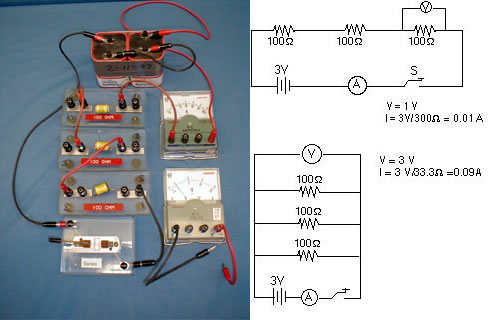Demos: 5B-07 Series and Parallel Resistances

A projectable voltmeter and ammeter are used to demonstrate the effective resistance of three resistors in (a) series and (b) in parallel.
Directions: The apparatus will be set up ahead of time by the lecture-demo technician. The series and parallel set-ups are labeled appropriately. The leads of the voltmeter are inserted into “banana” sockets at each resistor. Switch S is used to activate the circuit.
Suggestions for Presentation: In (a), we have the opportunity to show that the series resistances add (as evidenced by the 0.01 A current), but we can also show the voltage drops along the resistance in a series circuit. In (b) we can show that the voltage is the same across each element (so, in effect, each path is independent of the others), but also show that resistances DO NOT add in this configuration.
Extension: In the series arrangement, start with one resistor in the circuit (place a jumper wire from the end of the first resistor to the end of the last) and display the current. Then add another, etc. Show that the current drops as you resistors. Then in the parallel arrangement, do the same thing. It surprises many students that as you add in more resistors, the current in the battery goes up.
In the latter case, appeal to the students’ understanding of electrical bills. The more appliances you turn on, the more it costs. You are paying for energy, related to power, which is P =VI. Since the voltage is constant, you effectively are paying for current. So if plugging in more appliances costs more, it means there is more current, which means less resistance. If the resistance goes down when you add more resistors, it must mean a parallel arrangement.
Applications: Household circuits, some holiday light circuits.
Last Updated: Nov 30, 2023 11:25 AM